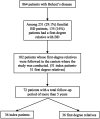Clinical Features and Phenotypic Similarities of Patients with Familial Behçet's Disease
- PMID: 40873392
- PMCID: PMC12317841
- DOI: 10.5152/eurjrheum.2025.24116
Clinical Features and Phenotypic Similarities of Patients with Familial Behçet's Disease
Abstract
Background: Behçet's disease (BD) exhibits significant phenotypic diversity. The genetic basis of phenotypic variations in BD has not yet been elucidated. Based on the high frequency of familial BD, we aimed to analyze the familial aggregation of various manifestations of BD in this study. Methods: Patients with BD from 3 Turkish tertiary rheumatology outpatient clinics were evaluated. Demographic and clinical characteristics of the familial group with either a first- or second-degree relative with BD and the non-familial group were compared. Afterward, patients in the familial disease group for 5 years or longer were divided into 2: an "index patient" and a "first-degree relative patient" and the presence of BD manifestations were compared between these 2 groups. Results: We identified 864 BD patients (mean age (SD): 47.9 (12) years, disease duration (SD): 83.7 (65.3) months) with 251 (29.1%) having a BD family history. Genital ulcers (P =.002) and papulopustular lesions (P < .001) were detected more frequently in the familial group. Also in the familial group, statistically significant correlations were detected between the index patient and the first-degree relativepatient in terms of erythema nodosum-like lesions (r: 0.398, P: .016), pathergy test positivity (r: 0.561, P: .002), peripheral joint involvement (r: 0.563, P < .001) and vascular involvement (r: 0.408, P: .014). Conclusion: Familial BD may differ from sporadic BD. Additionally, erythema nodosum-like lesions, pathergy test positivity, and vascular and joint involvement may tend to show familial aggregation.
Conflict of interest statement
Figures
Similar articles
-
Prescription of Controlled Substances: Benefits and Risks.2025 Jul 6. In: StatPearls [Internet]. Treasure Island (FL): StatPearls Publishing; 2025 Jan–. 2025 Jul 6. In: StatPearls [Internet]. Treasure Island (FL): StatPearls Publishing; 2025 Jan–. PMID: 30726003 Free Books & Documents.
-
Manifestations and predictors of neurologic involvement in Behçet's disease.ARP Rheumatol. 2025 Apr-Jun;4(2):174-176. ARP Rheumatol. 2025. PMID: 40629828 English.
-
Clinical characteristics of behçet's disease in palestine, a retrospective cohort study.BMC Rheumatol. 2025 Jul 24;9(1):93. doi: 10.1186/s41927-025-00544-5. BMC Rheumatol. 2025. PMID: 40702524 Free PMC article.
-
Bone marrow transplantation for Behçet's disease: a case report and systematic review of the literature.Rheumatology (Oxford). 2014 Jun;53(6):1136-41. doi: 10.1093/rheumatology/ket479. Epub 2014 Feb 6. Rheumatology (Oxford). 2014. PMID: 24505123
-
Gender-specific differences in Adamantiades-Behçet's disease manifestations: an analysis of the German registry and meta-analysis of data from the literature.Rheumatology (Oxford). 2015 Jan;54(1):121-33. doi: 10.1093/rheumatology/keu247. Epub 2014 Aug 12. Rheumatology (Oxford). 2015. PMID: 25118314
References
LinkOut - more resources
Full Text Sources

